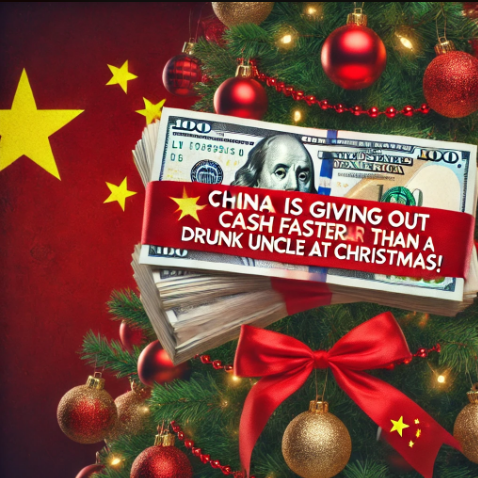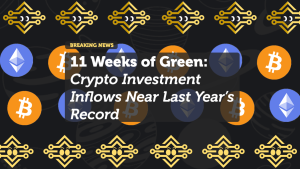
China is giving out cash faster than a drunk uncle at Christmas!
Economic Stimulus: China’s “Monetary Bazooka” to Revive its Economy
China has been firing off a rapid series of aggressive economic policies aimed at reviving its economy, which has recently been plagued by challenges such as deflationary pressures and a slowdown in key sectors. The government’s response has been swift and large-scale, and the financial world has been buzzing with phrases like “monetary bazooka” and even “Hail Mary” to describe the situation. One particularly colorful metaphor compares China’s economic stimulus to “a drunk uncle at Christmas” — distributing cash with reckless abandon.
Here, we’ll break down the recent key moves made by the Chinese government in five easy points. Buckle up!
1. Interest Rate Cuts: Cheaper Borrowing for All
China slashed its 14-day repo rate by 10 basis points (bps), bringing it down to 1.85%.
Translation: Borrowing just got cheaper! This encourages businesses to take out loans to grow and expand, and consumers to borrow money for spending. All of this is expected to stimulate economic activity by injecting more liquidity into the economy.
2. A Massive Liquidity Injection: Banks Get a Boost
A whopping 234.6 billion Yuan (approximately $33.3 billion) was injected into the Chinese banking system.
Translation: It’s like stimulus checks, but for banks. This gives financial institutions more cash to lend to businesses and individuals, boosting economic growth by ensuring that credit is available to fuel new investments and spending.
3. Reserve Requirement Ratio Cut: Banks Can Lend More
The Reserve Requirement Ratio (RRR) — the amount of cash banks are required to hold in reserve — was reduced by 50 bps.
Translation: By lowering the RRR, China is allowing its banks to lend and invest more of their money instead of keeping it locked up. This means banks can offer more loans to businesses and consumers, increasing liquidity in the market.
4. Mortgage Rates Lowered: Cheaper Monthly Payments
Existing home mortgages saw a 50 bps reduction.
Translation: Homeowners are getting a break! Lower mortgage rates mean reduced monthly payments, leaving consumers with more disposable income to spend or save. This move also encourages new home purchases, potentially stimulating the real estate sector.
5. Direct Stock Market Support: A Lifeline for Traders
China also provided 800 billion Yuan (approximately $1.14 billion) worth of support for the stock market.
Translation: The government is quite literally lending money to traders, allowing them to buy more stocks. This kind of support aims to stabilize the stock market, encourage trading, and build investor confidence.
It’s Alive! Chinese Stocks Rebound
China’s massive interventions have already sparked a major rally in the stock market. After the Chinese government purchased $90 billion worth of equity ETFs (exchange-traded funds), the market jolted back to life. Over the past two weeks, Chinese stocks have surged by 20%, with investors flocking back into the market.
In fact, the ripple effects have crossed borders. U.S. investors poured $630 million into the $ASHR ETF (which tracks Chinese stocks), pushing its assets up by 40%.
Why Is China Doing This?
China’s economy has been on shaky ground recently, with deflationary pressures threatening to stall growth entirely. From a slowdown in manufacturing to a struggling real estate sector, the challenges are broad and complex. By pumping liquidity into the system, lowering borrowing costs, and supporting the stock market, the Chinese government aims to:
- Boost spending and investment: Cheaper loans and more liquidity encourage businesses to expand and consumers to spend.
- Stabilize financial markets: Direct support to the stock market helps maintain confidence among traders and investors, which is crucial for economic recovery.
- Combat deflation: Stimulating demand through increased spending and investment helps push up prices, countering deflationary pressures.
The Bigger Picture: Long-Term Strategy or Short-Term Fix?
While these moves may jolt the economy back to life, there’s growing skepticism about the long-term sustainability of such aggressive measures. The metaphor of the “drunk uncle at Christmas” points to a potential downside — flooding the system with too much liquidity might provide immediate relief, but could it also lead to unintended consequences, such as asset bubbles or increased debt burdens? Some observers are concerned that while this aggressive monetary stimulus offers a short-term boost, it doesn’t address the deeper, structural issues plaguing China’s economy, such as over-reliance on real estate and manufacturing.
Conclusion: Will China’s Bold Moves Pay Off?
China is clearly going all-in on efforts to revive its struggling economy, with a multi-pronged approach designed to stimulate spending, support financial markets, and pump liquidity into the system. But as the Chinese government showers its economy with stimulus, the question remains: will these moves be enough to deliver sustained growth, or is it just a temporary fix to kick the can down the road?
Investors worldwide are watching closely, especially with Chinese stocks now rebounding. For now, it seems that China’s monetary “bazooka” has achieved its short-term goal — jolting the market back to life. But as the dust settles, the true test will be whether these policies can foster long-term stability without creating new risks in the future.
FAQs:
Q1: What is the Reserve Requirement Ratio (RRR)?
The Reserve Requirement Ratio is the percentage of deposits that banks must hold in reserve and cannot lend out. Lowering the RRR allows banks to lend more, increasing liquidity in the market.
Q2: Why is China lowering interest rates and injecting liquidity?
China is using these tools to stimulate economic activity by encouraging more borrowing, spending, and investment. This is especially crucial in times of economic slowdown and deflationary pressure.
Q3: What impact do these measures have on the global economy?
China is the second-largest economy in the world, so its economic health impacts global markets. When China injects liquidity and boosts its stock market, it often sparks investment flows from international investors.
Q4: What are the risks of China’s aggressive stimulus approach?
While the stimulus may boost short-term economic activity, it could lead to long-term risks like increased debt levels, inflationary pressures, or asset bubbles, particularly in the real estate and stock markets.
Q5: Will this stimulus fix China’s structural economic issues?
This aggressive stimulus might offer temporary relief, but it doesn’t address deeper structural problems such as reliance on real estate and manufacturing. Long-term growth may require more than just monetary interventions.
















